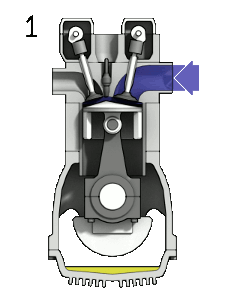(The text content below was given a Creative Commons license. This video is not included in that license but can be embedded in other websites online using the features available with YoutTube. Sorry for the poor quality of the video; it was one of the first we made with a limited budget and if it wasn’t for the learning-oriented host it would almost be unwatchable by today’s internet viewer’s standards, but the information is still current and Jeff did a good job explaining things for the layperson to understand.)
In this lesson you’ll learn how an internal combustion engine works and the importance of engine oil.
How an internal combustion engine works:
All internal combustion engines operate on a theory called the Otto Cycle of events, named after Nikolaus Otto, who invented it in 1867. It occurs in 4 repeating steps or “strokes”:
- Intake
- Compression
- Combustion (or power)
- Exhaust

Diagram showing the operation of a 4-stroke spark ignition engine. Labels: 1 ‐ Induction, 2 ‐ Compression, 3 ‐ Power, 4 ‐ Exhaust. CC-BY-SA 3.0 Zephyris
The fuel and air are drawn into the engine cylinder by the piston moving down while the intake valve is open. Then the piston starts moving up, both intake and exhaust valves are closed. The piston moving up compresses the air and fuel mixture. Then the air and fuel mixture is ignited with a spark plug (in regular gasoline engines), creating combustion. The extreme heat creates high pressure forcing the piston down. Then the exhaust valve opens. The piston goes back up exhausting the exhaust gas. And then the cycle repeats itself.
Here is a decent animation of the Otto cycle in gif format on wikipedia: https://commons.wikimedia.org/wiki/File:4StrokeEngine_Ortho_3D_Small.gif. (In the gif animation the intake is on the right and the exhaust is on the left).
The process of combustion is the conversion of chemical energy (gasoline) into heat energy (combustion) which is converted into reciprocating energy (pumping of the pistons). The pistons turn a crank shaft via a connecting rod. As the piston goes up and down during combustion it rotates the crankshaft. The crankshaft turns reciprocating energy into rotational energy. This energy is eventually transferred to the wheels through the drivetrain, which we discuss later in Lesson 9.
An animated illustration showing pistons (gray) in their respective cylinders (blue) and a crankshaft (red) can be found at http://commons.wikimedia.org/wiki/File:Cshaft.gif. As the pistons go up and down the crankshaft is rotated.

Crankshaft gif animation, public domain.
In a diesel engine there are no spark plugs. The fuel is ignited based on compression alone. The compression is higher in a diesel engine, which generates enough heat to cause the combustion.
A hybrid vehicle uses an electric motor and battery for assisting propulsion along with the internal combustion engine. The internal combustion engine generates electricity to recharge the batteries. Also, the batteries are recharged when braking to a stop.
Engine Oil
The purpose of engine oil is to form a film of lubrication between all moving parts of an internal combustion engine to reduce friction and wear. Choosing the right engine oil for your vehicle and changing the oil during regularly-scheduled maintenance intervals will keep the engine running smooth over time. The recommended oil type and specification for your vehicle can be found in the owner’s manual. Another place to find it is on the oil fill cap. It will be based on the ambient temperature where you live. There are two engine oil codes that the owner’s manual will specify, an API and an SAE.
All oil has an API code which stands for American Petroleum Institute. It’s a service rating for the quality, cleanliness, and types of detergents in the oil. The code will always be two letters.
The SAE is the viscosity or thickness of the oil. Modern oil is multi-viscosity oil. The SAE may be something to the effect of 5W-30. The first number-letter combo (5W) indicates the viscosity or thickness of the oil when it is cold. The second number is the viscosity at the engine operating temperature. Before they had multi-viscosity oil there was only single-viscosity oil (SAE 30), which in cold weather is extremely thick. Trying to pour it into your engine would be like pouring honey, but more importantly it would be hard to pump the oil and lubricate the engine. That’s why older engines had to be warmed up before you could drive them.
Lesson 5: The Internal Combustion Engine & Engine Oil is one of twelve lessons that are also available as a free ebook download which is complete with illustrations. These lessons are based on the outline for the Boy Scout Automotive Maintenance merit badge and adapted by Crawford’s Auto Repair for a general audience. This article is for informational purposes only and the author does not assume responsibility or liability for any accident that may occur when working on motor vehicles. By reading this page you accept the condition that you are ultimately responsible for your own actions. For additional information on the topics on this page see Engine Repairs & Lubrication and Oil Change & Works Package.
Copyright © 2014, Jeff Crawford. Permission is granted to republish this article for personal or commercial use as long as the content, citation, and copyright notice all remain intact and unchanged. There must be an active “follow” link to CrawfordsAutoService.com.
Lesson 5: The Internal Combustion Engine & Engine Oil is licensed under a Creative Commons Attribution-NoDerivatives 4.0 International License.


No Comments
Sorry, the comment form is closed at this time.